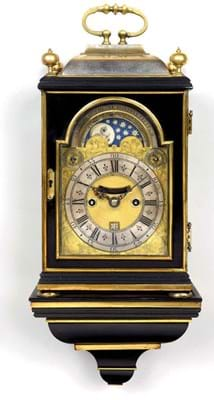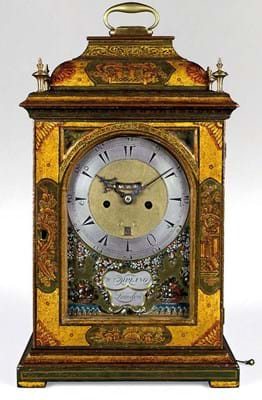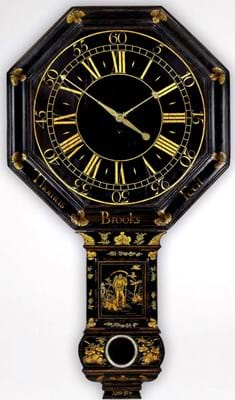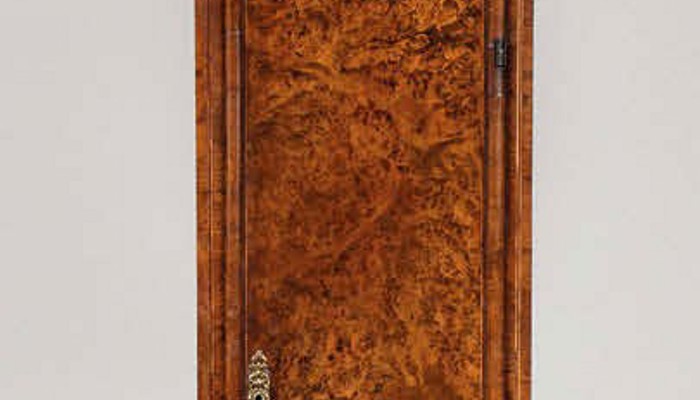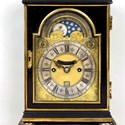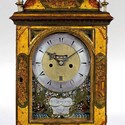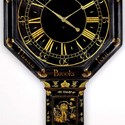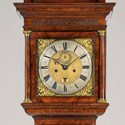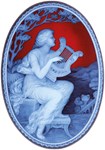A fine semi-miniature George I period table clock by Claudius Du Chesne is a favourite piece of clock dealer Howard Walwyn. He offers it for sale as part of an anniversary exhibition at his Kensington Church Street shop this month.
The ebonised and brass moulded moonphase clock, c.1720, has an eight-day movement, a 4½in (12cm) dial with fine Huguenot style foliate engraving and a subsidiary dial in the arch for the phases of the moon. The maker’s signature Claudius Du Chesne Londini Fecit is on a plaque above.
“It is an exceptional piece,” Walwyn says. “Du Chesne was well-known and widely regarded as one of the finest French Huguenot makers. He came to London from Paris in 1685 as a refugee.”
Walwyn adds that there is a later, lesser example from the same maker in the Lyme Park Collection in Cheshire. His example is offered at £75,000.
Golden period
At the Sign of the Dial: Rare English Clocks by Great Makers runs from November 12-26.
It marks the dealer’s 25th year trading on the west London antiques road and features an array of fine and rare timekeepers, many from the Golden Age of English horology. It was during the remarkable period from around 1660-1720 that quantum leaps were made in timekeeping through inventions such as the pendulum clock and the anchor escapement. New standards of workmanship and cutting-edge technologies combined to capture the attention of the upper classes.
The exhibition takes its name from the dial symbol that was commonly hung outside the premises of a 17th or 18th century clockmaker. Signs made shops recognisable in the days before many people could read – convenient when servants ran errands for their clock-owning masters.
The great Thomas Mudge (1715- 94), for example, advertised himself at the Dial and One Crown while the greatest of them all, Thomas Tompion (1693-1713), operated from the 1670s at the sign of The Dial and Three Crowns in Water Lane (now Whitefriars Street) off Fleet Street.
It was here that he worked on his movement designs with the physicist and mathematician Robert Hooke (1635-1703), eventually coming to the attention of Charles II. Tompion went on to work for the king and his successors: James II, William & Mary and Queen Anne.
Three Tompion clocks are available at the Walwyn show.
The highlight is a previously unrecorded William & Mary period walnut and mulberry veneered longcase offered at £275,000.
It emerged from a private collection in the north of England. As is indicated on an old trade label inside the trunk door of the case: This clock stood for many years at Halswell Hall Devonshire the ancestoral [sic] home of the late Lord Wharton.
It is numbered 241 on its movement, case and original winding key, dating it to around c.1694. Tompion’s numbering system, devised c.1682 for accounting purposes rather than posterity, is thought to be the first serial numbering system applied to manufactured goods.
A ‘pre-numbered’ Tompion longcase, c.1680-85 is housed in a floral and bird marquetry case of a type associated with Jasper Braem (fl.1677-96). By 1677 Tompion was subletting part of his premises – The Dial and Three Crowns at Water Lane – to Braem, a Dutch cabinetmaker who was probably the case maker for at least some of Tompion’s more decorative longcase clocks. Completing the trio of Tompions is a rare ‘Phase I’ ebony table clock, c.1682.
From the next generation of London makers is a green and gilt lacquer table clock made c.1745 by William Kipling. Apprenticed in 1695, he had workshops at Ratcliffe Cross from 1705-50 and specialised in clocks like this, made for export to the Ottoman Empire.
The eight-day arched brass dial movement on this example features Turkish numerals, showing it was one of his creations for the eastern market. It is offered for £28,000.
Cultural exchange
More cross-cultural exchange is evident to a large c.1735 shield dial tavern clock by Thomas Brooks, available for £30,000.
Its case is decorated with raised gilt lacquer chinoiserie – the central figure of Father Time enjoying an Oriental landscape. An unusual and early feature for a tavern clock is a glass lenticle, for observing the swinging pendulum, but what marks out this clock is its size, At 3ft (91.5cm) across, it is one of the largest the dealer has owned.
Other offerings from later in the Georgian period include a mahogany hooded wall clock c.1780 by Francis Perigal (fl.1741-70) and an 1835-40 mahogany trunk dial wall clock by Benjamin Lewis Vulliamy.
Walwyn is a member of BADA, LAPADA, CINOA, as well as being a member of the Worshipful Company of Clockmakers, and has dealt for more than 30 years in English clocks and barometers of the 16th-19th centuries.


